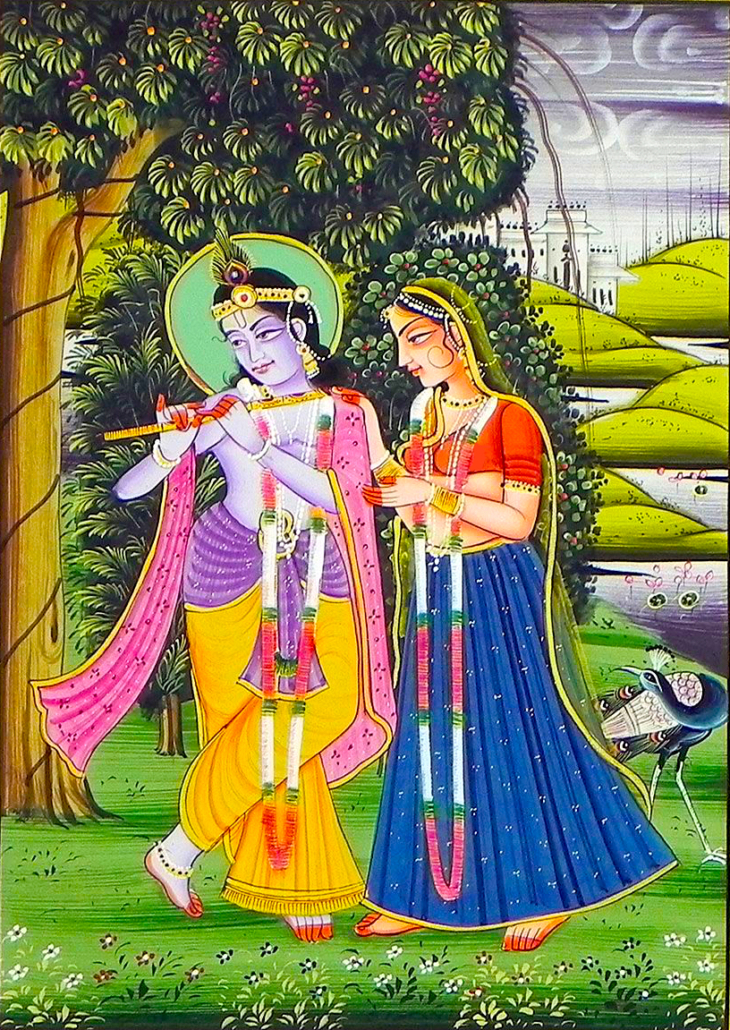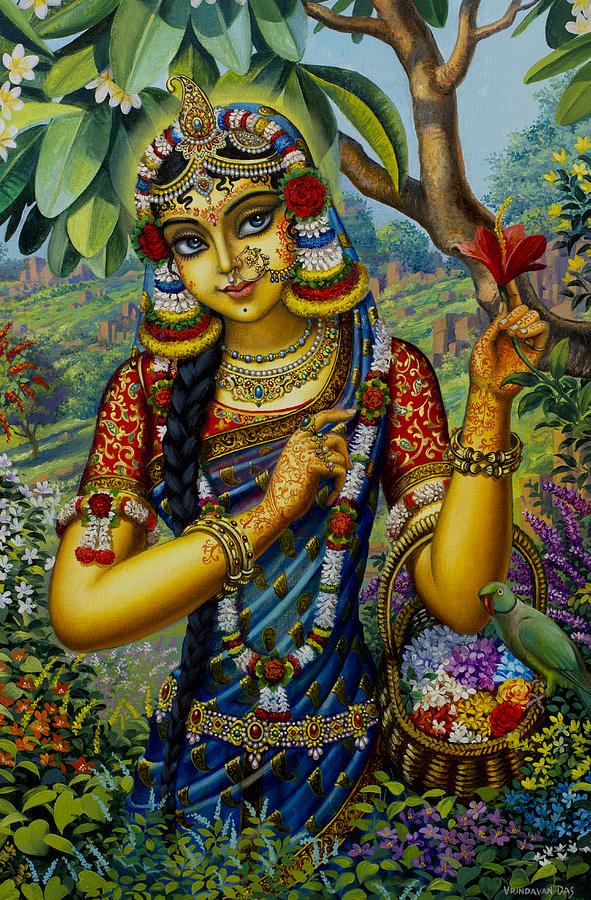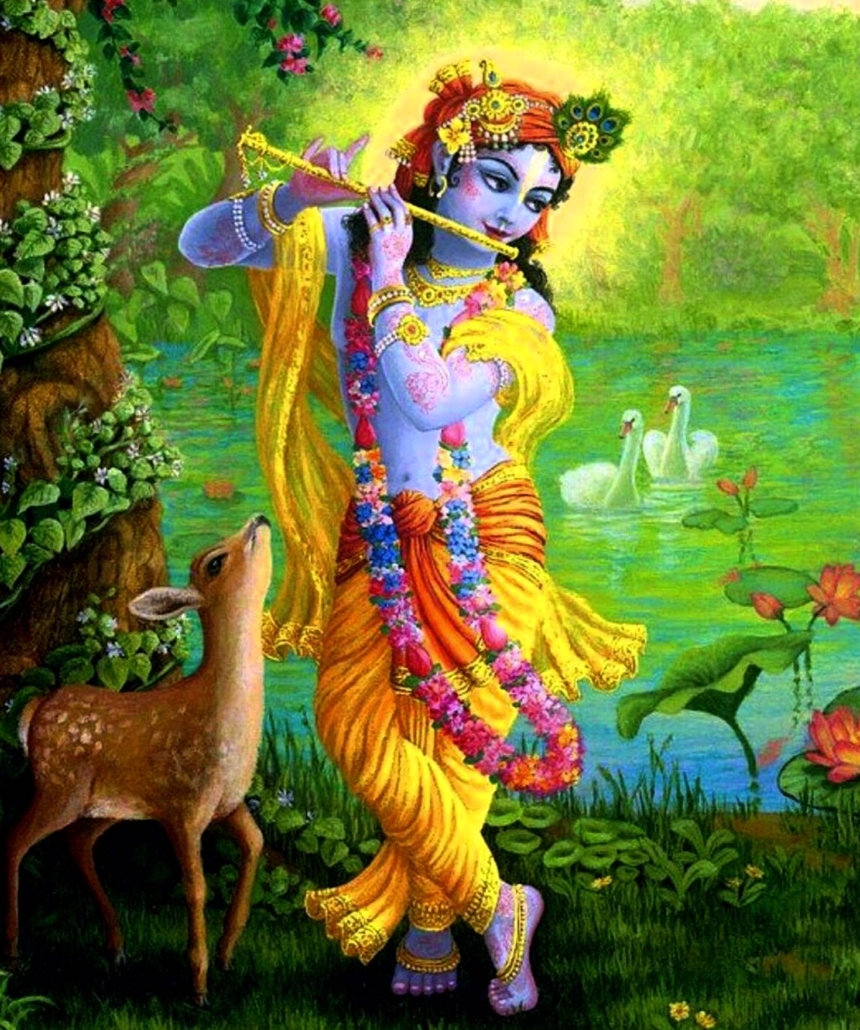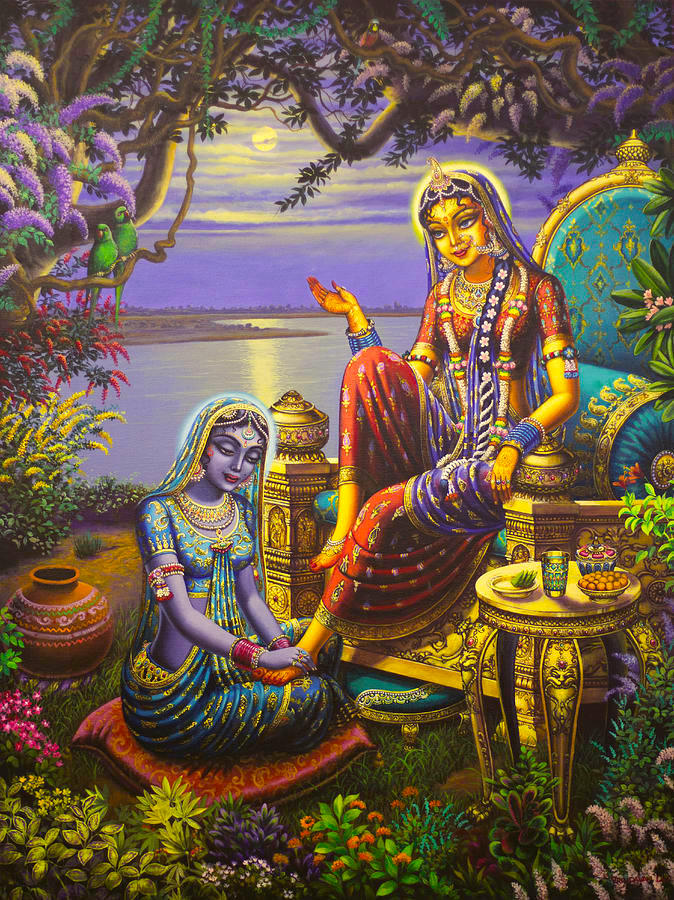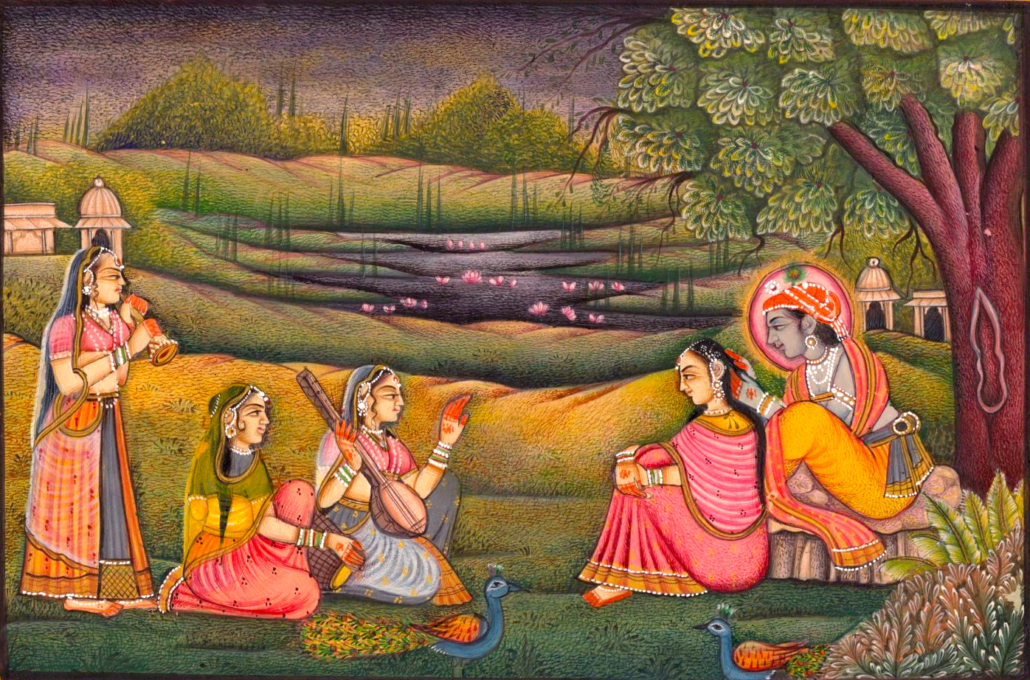Mahanidhi Madan Gopal Das
The Ten Amazing Seasons of Vraja
Because the seasons and forests are inseparable, we will first describe the astonishing transcendental forest of Vrindavana, which overflows with all wonderful attributes. Though the forest of Vrindavana contains the matchless essence of the majesty of Vaikuntha, it also features limitless sweetness and splendor that eternally manifests in newer ways at every moment.
The ever-increasing natural beauty of the forest kunjas rivals majestic houses made of priceless jewels. What exactly makes a kunja? The corners of the forest cottages (kunja) are formed of four tall kadamba trees which have many leafy branches that hang down to make natural canopies. Each of these four trees is encircled by two creepers appearing like a pair of embracing lovers. The creepers entangle with the flowers, leaves, and fruits of these trees to create a wonderful panorama of color, design and depth.
The four walls of the pastime cottages (kelimandirs) are made of flowering madhavi creepers that comprise the walls of the pastime cottages. The entwined branches of various creepers form the cottage doors that are surrounded by other fragrant creepers. Varieties of colorful flowers hang down to make the domes above the cottages. When the wind blows, these dangling flower creepers move about as natural camara fans to please Priya Yugala.
The sweet sounds of bees and cuckoos echo through the kunjas that are lit by phosphorescent vines. For the pleasure of Radha-Govinda, the kindly musk deer scent the air, and the camari cows sweep clean the forest floor with their long bushy tails.
Although the forest realm of Vrindavana exists beyond the reaches of time, it appears to display six unique seasons. Though resembling their material counterparts, the six seasons of Vrindavana are completely transcendental, charming and unlimitedly sweet because they exist only to increase the spiritual bliss of Krishna’s pastimes. The six seasons are known as: the joy of monsoon, the pleasure of autumn, the satisfaction of winter, the happiness of the dewy season, the beauty of spring, and the auspicious season of summer.
Besides the six distinct seasons mentioned above, the divine realm of Vrindavana is distinguished and beautified by three more seasons appearing in pairs as autumn and winter, dewy and spring, summer and monsoon. In this way, Vrindavana features nine seasonal forests.
But wait! There are actually ten seasonal divisions in Vrindavana (the six different seasons, the three combinations, and the six seasons together simultaneously manifesting in the same place as experienced in aprakata Sri Radha Kunda. Thus, Sri Vrindavana Dhama has ten different seasons!
In the tenth season (all six seasons at once) the youthful gopis take fresh kadamba flowers from the rainy season and fix them in their hair parts. They twirl autumn season lotuses in their petal like fingers, smear the pollen of winter lodhra flowers on their cheeks, and put bandhuli flowers from the dewy season around their necks. They place bunches of asoka buds from the spring over their ears, and entwine mallika garlands in their hair from the summer season. Every day, the Vraja gopis beautifully decorate themselves like this to worship their PriyatamaShyama.
Now we will describe the six major seasons of VrajaDhama which are the source of the ten individual forests.
The Six Seasons of Vraja
1. Rainy Season (monsoon)
During monsoon season the constant torrential rain showers resemble the intense pleasure derived from rendering pure, unalloyed devotional service. As a self-realized person becomes illumined with the eternal light of bliss, this season illumines the sky with flashes of flickering lightning which satisfy the heart. Clamoring dahuka birds mimic the conflicting arguments found in books of logic. Arjuna trees appear like a second sun to brighten all directions with their bold red flowers.
Rain showers during particular naksatras summon effulgent emeralds appearing like tender shoots of grass. The camuru deer mistake the emeralds for shoots of grass and try to nibble on them. When’ the indragopa (tiny red insects) crawl on these emeralds, they appear like tiny rubies moving across a green bodice stretched across the breast of the earth.
Kadamba flowers fill the air with a sweet herbal aroma. Due to the constant pouring of misty rain, the air always feels cool and refreshing. The rumbling clouds sound like cataki birds crying in anguish, “Please give us rain and save our lives.” The clouds answer, “Do not lament, I will rain now.”
The monsoon season abounds with a symphony of sounds. Everywhere catakabirds call, tithi birds chirp, daduri birds cry, peacocks wail piteously, clouds roar, and raindrops pitter-patter. The nourishing waters of this season beautify all the trees and gardens.
The abundant ripened fruits of the mango trees tint the center of the forest with a golden glow. With all kinds of colorful hues the gardens of Vrindavana appear as beautiful as a painting.
2. Autumn Season
Lakes of Vraja
The splendorous season of autumn is characterized by lakes full of deep blue water filled with red lotus flowers that look like the lotus feet of Visnu being caressed by the loving lotus hands of Laksmi. Brimming with water, these lakes are as clean and pure as the sinless heart of a devotee aspiring for prema. As Narayana is beautified by the presence of the joyful Goddess of Fortune, similarly, the autumn lakes are beautified by the presence of cakravaka birds and blossoming lotuses.
Groups of lazy swans sport freely in the lakes. Gliding along the water, they resemble liberated souls (parama/hamsas) swimming in the ocean of spiritual bliss. The cooing herons appear to be echoing the tales of Rama and Laksmana. Blue lotuses please everyone with their splendid fragrance, spreading through the land like the fame of the all-attractive Lord Sri Krishna. Red lotuses cast their colors across the autumn lakes like the setting sun coloring the evening sky with it pastel pinks.
The autumn moon shines brilliantly like a glinting sword unsheathed before battle. The large lakes of this season like Shyama and Radhakundas are very beautiful with warm water on their surfaces and cool water within. They resemble a peaceful man who keeps cool within, even when harassed by the hot words of a fool.
These cloud wisps appear like the white scarf of a young woman waving in the breeze, or cotton fluff carried by the winds personified as young girls. When the groups of pure white clouds reflect in the Yamuna, it appears like a brilliant white sandbar in the middle of the river. Three wonderful features fill the autumn season with bliss, namely the fragrant pollen from blooming lotuses, the directions darkening due to the swarms of bees maddened by the intoxicating fragrance of the chatima tree, and the wind driven clouds moving like freely roaming elephants.
Kaviraja Sri Karnapura Goswami’s Ananda Vrindavana Campu ki jai!
Radha-Govinda Vraja Lilas ki jai! DasaRtuVanaVrindavana ki jai!
Jai Jai Sri Radhe!
All parts of Krishna Nectar Lilas can be found here.

